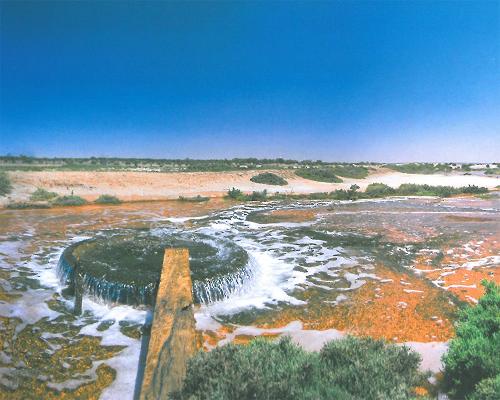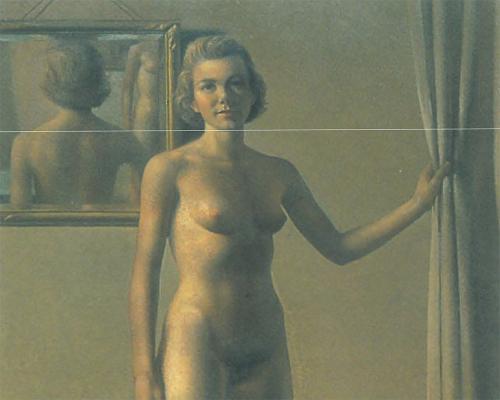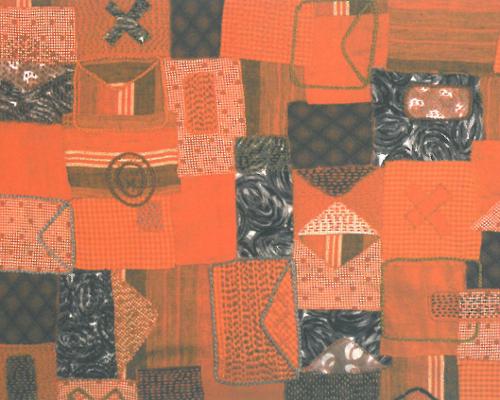
Themes of presence and absence were revealed in the work of three contemporary photo media artists, Martin Smith, Sharon Green and Annie Hogan, who exhibited recent work at Stratton Gallery in Brisbane during December. As the title looking at yourself looking at yourself suggests, the artists reflected on the self-contemplative aspects of their work, investigating personal and cultural memories; notions of identity, the gaze and desire; and the discernible or concealed histories of private spaces, through their work.
The artists displayed distinct styles and uses of photo media, from the montaged, back-lit prints on film of family portraits in Martin Smith's work, to the slick, wet-glossiness of Sharon Green's type C photographs, and the warm, inviting satin surfaces of Annie Hogan's type C photographs. All of the works enticed the viewer to contemplate what was missing and evident in the images, using an intriguing combination of revelation and ambiguity of symbolism.
Martin Smith's work I'll see you next Thursday (2000) examined family relationships and the experience of personal loss and grief. This biographical series was developed over several months and was described in the catalogue as a collaborative work between Martin Smith and his recently deceased sister, Donna Philip. Black and white portraits of Donna's son, Sam, taken by Smith every Thursday over an eight-month period, were juxtaposed with faded, grainy colour photographs of different locations taken by Donna. Portraits of other family members were also situated in relation to images of Sam, creating a dialogue between different generations about impressions of belonging and loss. The stark contrast between the focused black and white images and the blurry coloured images operated metaphorically to represent the presence of Sam and other family members in the present, and the absence of Donna in a remote past. Juxtaposing images in this way created fragmented narratives that effectively evoked the sensation of remembering, as they stimulated an emotional response without necessarily disclosing the whole event. A book describing Smith's family history from his perspective accompanied the photographs, however this adjunct was probably not necessary for communicating what Smith attempted to express – a sense of loss and longing for something/someone that is missing. Nevertheless, it fulfilled a cathartic purpose and enabled viewers to personalise the images to a greater extent.
Sharon Green's Fallen series (2000) consciously explored the dynamics of the gaze, femininity and desire, overtly referencing Judeo-Christian myths of female sexuality and 'original sin' through recurring symbols such as the apple, snake, blood and blooming flowers. These glossy, luxuriant triptychs positioned fragments of architecture, women in brocade frocks (usually the central image), lilies, pearls and other symbols together to articulate a link between the Madonna/Whore myth and contemporary perceptions of female sexuality. Interestingly, the seductive aesthetics of these images were subverted by the fusion of baroque iconography with symbols of abjection – death, blood, vampirism and menstruation. A discernible connection between lavish architecture and established codes of femininity could be made in the context of these works, as the practices of adorning these spaces (buildings and the female body) creates an illusion that disguises the physicality of these locations. Green disrupted this mirage by symbolically exploring that which is below the surface, divulging the materiality of these localities and the ever-present threat of decay and imperfection. My main criticism of this work is that the symbolism seemed a little too obvious, especially those which referred to Biblical myths of temptation. The stronger works maintained an air of ambiguity, while referencing historical representations of female sexuality and desirability.
.jpg)
There was a strangely familiar, yet alienating quality to the interior domestic settings documented in Annie Hogan's type C photographs, as the rooms were often empty of homely objects, while seeming to be full of memories. From a distance the rooms appeared quite lush and pristine, glowing with colour and energy. This illusion was short-lived however, with the residues of human use being revealed as one approached the images. Chipped paint, dinted fibro walls, cracked windows and deteriorating curtains remained inscribed on these rental houses like battle scars from forgotten wars. Hogan studied these domestic spaces from different vantage points, framing walls, floors, corners, windows and doors from divergent perspectives. Natural light was captured as it filtered through bare, curtained and shuttered windows, often creating patterns across the wall or floor as it streamed in. This approach transformed these apparently ordinary domestic spaces into extraordinary locations, evoking mysterious, ghostly and ethereal ambiences. This was especially evident in Nebulous, Comfort and Untitled 1. Hogan's photographs not only documented the interior architecture of old timber houses in Queensland, they stimulated memories about the experiences of living in or visiting these places. Myths of the family home as a site of nurturing, protection, unity, belonging and energetic activity, were bought into question by their depiction as empty, deserted and obscure zones.
looking at yourself looking at yourself is a successful example of an independent initiative where three artists, working with different styles and concerns, collaborated to present their work in a professional and cohesive manner. Although the curatorial rationale was very broad, it was specific enough to reveal some synergies in three divergent bodies of work. Overall, the sensation of absence and longing, along with the focus on myths of identity and desire, dominated the exhibition. A major achievement for these artists was that this exhibition indicated that Martin Smith, Sharon Green and Annie Hogan are three emerging Queensland artists who are worth keeping an eye on.












